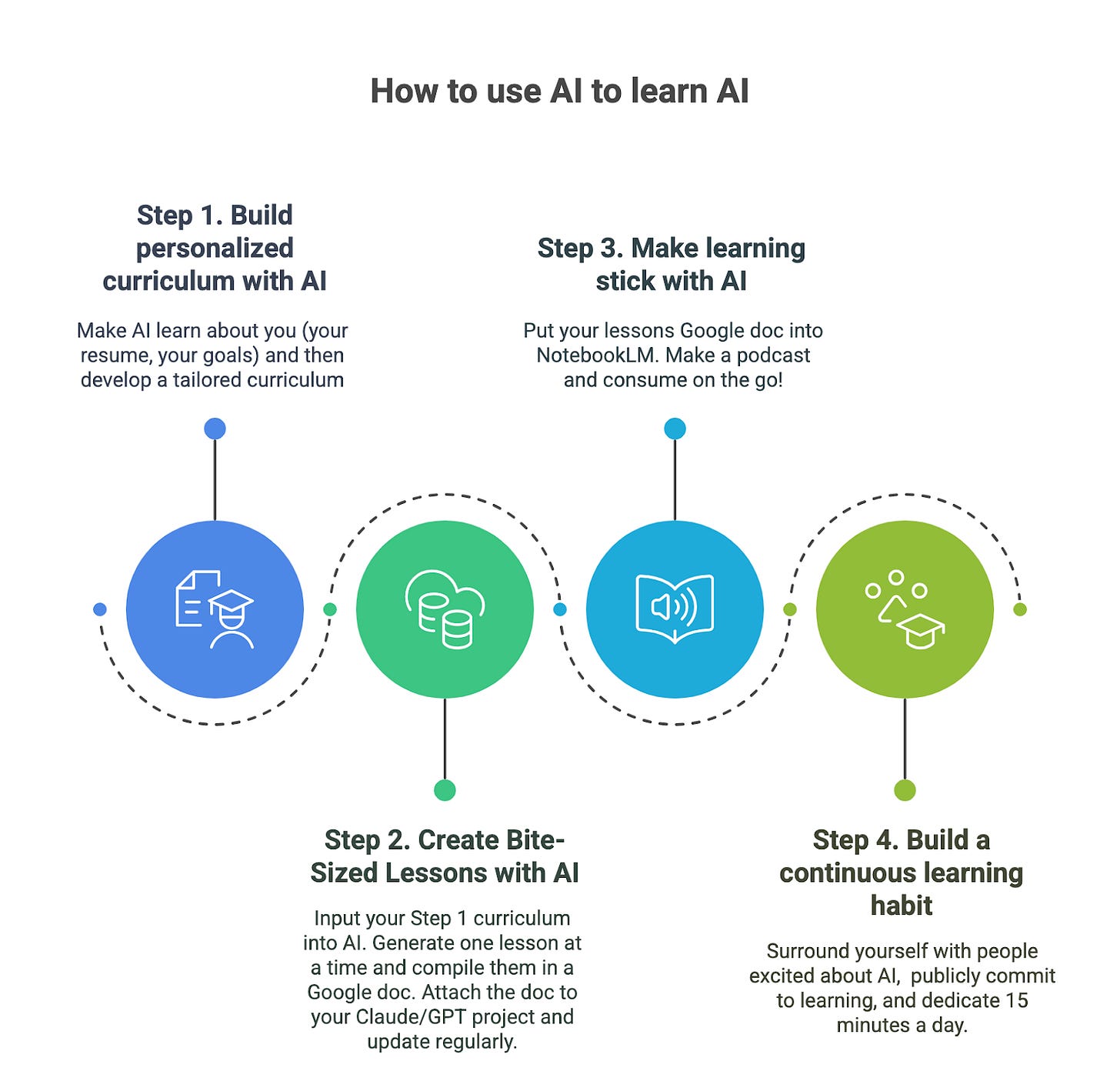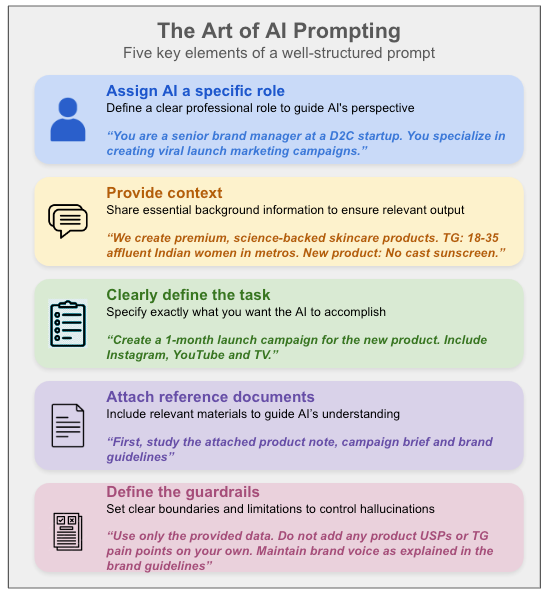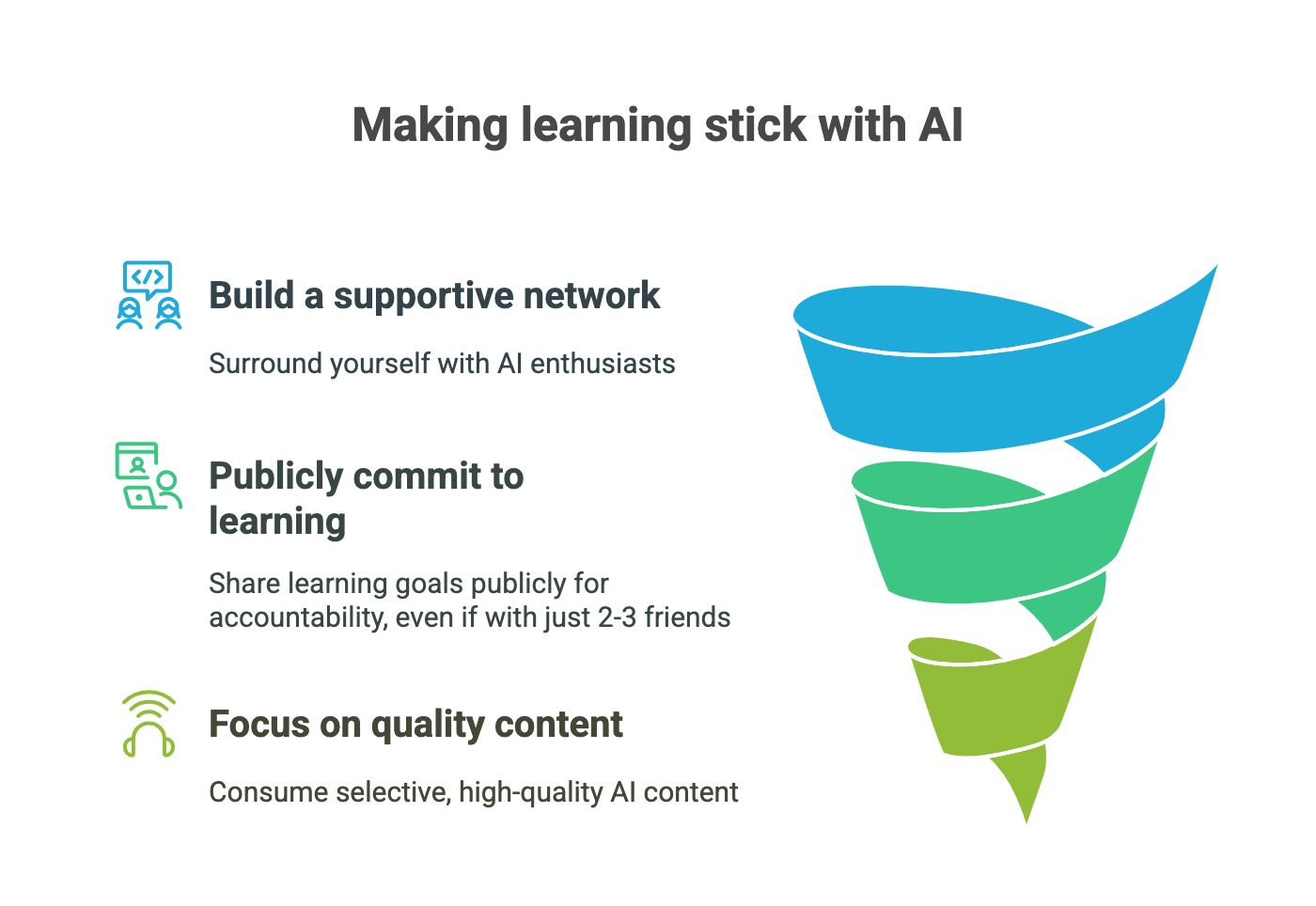How to use AI to learn AI (and anything else)
The ultimate learning hack for busy professionals
Summary
Ever found yourself staring at a blank search bar, typing "how to learn [insert trendy skill]" only to get overwhelmed by hundreds of online courses, YouTube tutorials, and conflicting advice?
There's a flood of generic AI content out there that leaves you no smarter after consuming it. Most videos and courses just scratch the surface without delivering practical value. We learned the hard way that the most effective approach is to ditch the passive learning and start using AI as your personal learning companion. It's meta-learning at its best.
In this post, we'll share a practical framework that we used ourselves to get started with AI - no technical expertise required! We'll explore:
The meta learning advantage
How to build a personalized learning plan with AI
Creating customized bite-sized lessons with AI
Making learning stick using AI
How to build a habit of continuous learning (even with a busy schedule)
Let's go! 💪
The meta learning advantage
Information overload is real, especially when it comes to AI. As a business leader, you've likely experienced that moment of typing "How to learn AI" into Google and facing a barrage of courses, tutorials, and conflicting advice. This quickly becomes overwhelming - especially when you are trying to learn something in a crunched time.
But here's the twist: Using AI to learn about AI creates a powerful feedback loop that accelerates your understanding in ways traditional learning methods can't match.
Nothing beats learning by doing
When you use AI tools to learn AI, you're not just doing passive reading - you're actively engaging. It's like learning to swim by getting in the water rather than watching YouTube tutorials about swimming. 😐
Every interaction with AI becomes a mini-lesson, giving you an intuitive understanding of how these systems function, what they are capable of, and what they lack.
By this point, we can almost hear you asking, “OK, I get it. But where do I even start?”. Let’s explore that next.
Becoming a pro at prompting
The first step to mastering AI is becoming great at prompting. Unfortunately, prompt engineering isn't intuitive communication. It feels unnatural at first - it's a muscle you build only with practice, ideally daily or multiple times a week. The better your prompts, the more valuable the outputs. Below is a quick recap of how to structure a prompt:
For more details on how to write a great prompt, check out our detailed blog post.
Pro tip: For your common use cases, keep an eye out for which prompts are working well for you. Save those and build your personal "prompt library" so you don't waste time rewriting the same instructions repeatedly. Or better still, create dedicated projects in Claude or ChatGPT with prompts saved in the instructions.
Step 1: How to build a personalized learning plan with AI
Now that you understand the meta-learning advantage, let's create your personalized AI learning plan or curriculum. The beauty of using AI for your curriculum is that you get it tailored to your background, goals, and time constraints.
Here's a sample prompt you can use to get Claude or GPT to create a personalized curriculum for you:
Sample GPT/Claude prompt to create your learning plan (attach your resume with this)
You are a generative AI expert who specializes in helping non-technical business leaders understand and leverage generative AI.
First, review my resume and create a summary of my profile (e.g. education, years of experience, core skills, functional expertise, industry expertise).
Next, ask me 3-5 clarifying questions about:
- My specific learning goals with AI
- My current level of understanding about AI
- How much time I can dedicate to learning weekly
- Which aspects of AI are most relevant to my role
- How I prefer to learn (reading, videos, interactive exercises)
After I respond, create a personalized learning plan with:
- 4-6 bite-sized lessons (20-30 minutes each)
- Clear lesson titles
- 2-3 specific topics covered in each lesson
- Learning outcomes for each lesson
- Suggested exercises to practice what I've learned
Remember that my goal is to understand AI deeply at a conceptual level so I can 10x my daily output.The key is being specific about your current knowledge and goals. This helps the AI target your exact needs rather than giving generic advice you could find anywhere.
Pro tip: Save this conversation or create a project in Claude or ChatGPT so you can easily return to your personalized curriculum.
Step 2: Creating customized bite-sized lessons with AI
Now that you have your learning plan, let's use AI to create digestible lessons as per that plan.
The Feynman Technique, AI style
The Feynman Technique is one of the most effective learning methods: understand a concept so well you can explain it to a child. AI excels at implementing this approach.
Try this prompt to break down complex AI concepts:
Sample GPT/Claude prompt for creating your tailored lessons
You are a generative AI expert who specializes in teaching non-technical leaders generative AI. Create bite-sized lessons for me that will take 15 minutes to read, using the below curriculum: {insert curriculum from Step1 here}. Create only one lesson at a time and confirm with me before moving to the next lesson.
Explain the concepts using the Feynman Technique:
1. Explain it in simple terms as if to a smart 12-year-old
2. Identify any technical terms you used and explain those simply
3. Use a real-world analogy from business
Focus on practical applications for sales/marketing/product/operations/finance.Pro tip 1: Notice how we inserted the output from Step1 into the prompt in Step2. This is called prompt chaining, where you use LLMs in a series to build on each other’s output.
Pro tip 2: Save your curriculum and lessons in a Google Doc (let’s call this your “Personal Textbook”), then connect it to a Claude Project with your learning prompt in the instructions. This creates a persistent learning environment where you can easily pick up where you left off.
Step 3: Making learning fun with AI
By now, you have your tailored curriculum and lessons. The next challenge is internalizing this knowledge. It can feel like a chore to go over technical topics at length. With AI, you can turn boring study into engaging experiences that fit seamlessly into your lifestyle.
Turn your notes into personal podcasts
With NotebookLM, you can convert your learning materials into super engaging audio content with a few clicks. Simply upload your "Personal Textbook" document from the previous step, generate a podcast, and listen during your commute or workout—turning "dead time" into learning time.
Create fun personal AI assistants
Another effective strategy is to use AI for personal use cases beyond work. Create assistants for planning and tracking fitness goals, or as a personal coach. The key is choosing use cases you'll engage with frequently to build your prompting skills through regular practice.
Step 4: Building a habit of continuous learning
Even the best learning system fails without consistency. Here are some hacks we've used to make AI learning sustainable:
Surround yourself with people who are excited about AI. Whether it's a Whatsapp group of AI enthusiasts or a few friends, having a network to discuss and share learnings dramatically increases retention and motivation.
Commit to learning publicly. Even sharing your weekly goals with 2-3 close friends creates enough positive pressure to maintain momentum.
Consume limited, high quality content. Instead of random exploration, bookmark 1-2 quality podcasts or newsletters on AI. This creates a reliable stream of relevant information without the overwhelm.
For courses on AI, we highly recommend Coursera and Deeplearning. Some other great content we follow personally:
The OG of AI, Andrew Ng’s newsletter
Twitter accounts worth following: Andrej Karpathy, Deepmind, Deedy Das, Deepseek
Wrapping it up
Remember - Consistency beats intensity when it comes to learning. Dedicate 15-20 minutes a day to build momentum. Try this framework, experiment, and see the impact. Share your learnings in the comments - let’s grow together. Happy learning, and here’s to unlocking your full potential with AI!








I like things in this article that information is crisp and clear. The aim was clear that one should adopt self learning. In this article I also like that that provides a strategy how to do that but not remembering the so called formulas but clearing the core concepts without fearing anything. AI is helpful so as the writers of the article to how to get help not spreading the fear.
Thank you